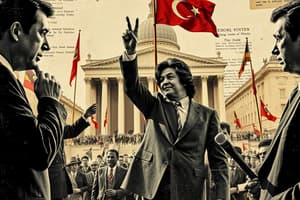Podcast
Questions and Answers
¿Cuándo comenzó la experiencia democrática moderna en Ecuador?
¿Cuándo comenzó la experiencia democrática moderna en Ecuador?
- En 2000
- En 1990
- En 1960
- En 1979 (correct)
¿Qué práctica electoral excluyente se menciona en la Constitución de 1979 de Ecuador?
¿Qué práctica electoral excluyente se menciona en la Constitución de 1979 de Ecuador?
- Sufragio universal
- Voto obligatorio
- Sistema electoral de dos rondas (correct)
- Sistema proporcional de votación
¿Cuándo se les concedió a los indígenas ecuatorianos el derecho al voto?
¿Cuándo se les concedió a los indígenas ecuatorianos el derecho al voto?
- En 1978 (correct)
- En 1965
- En 1985
- En 1995
¿Qué tipo de representación política se menciona como 'negligible' para los indígenas en el artículo?
¿Qué tipo de representación política se menciona como 'negligible' para los indígenas en el artículo?
¿Qué sistema electoral beneficiaba a los partidos políticos establecidos y a las élites políticas según el texto?
¿Qué sistema electoral beneficiaba a los partidos políticos establecidos y a las élites políticas según el texto?
¿Qué impacto tuvieron las políticas neoliberales en las comunidades indígenas de Ecuador durante los años 80 y 90?
¿Qué impacto tuvieron las políticas neoliberales en las comunidades indígenas de Ecuador durante los años 80 y 90?
¿Qué fue una de las reformas clave introducidas por la Asamblea Constituyente de 1998 en Ecuador?
¿Qué fue una de las reformas clave introducidas por la Asamblea Constituyente de 1998 en Ecuador?
¿Qué papel desempeñaron movimientos sociales como CONAIE y AP en Ecuador durante los años 90 y principios de los 2000?
¿Qué papel desempeñaron movimientos sociales como CONAIE y AP en Ecuador durante los años 90 y principios de los 2000?
¿Qué logro la constitución ecuatoriana de 2008 en términos del sistema electoral?
¿Qué logro la constitución ecuatoriana de 2008 en términos del sistema electoral?
¿En qué estado se encuentra actualmente la democracia en Ecuador según el texto?
¿En qué estado se encuentra actualmente la democracia en Ecuador según el texto?
Flashcards are hidden until you start studying
Study Notes
Democracy in Ecuador: Exploring Exclusion in Early Years
In the realm of Ecuadorian politics, democracy has a rich history marked by triumphs and challenges. One particular aspect of this history that deserves closer scrutiny is the issue of exclusion in the nation's early democratic era. This article will delve into the evolution of Ecuador's democratic structure, with a focus on the marginalization of specific groups in the country's first two decades of democratic rule.
The Beginnings of Ecuadorian Democracy
Ecuador's modern democratic experience dates back to 1979 when the country transitioned from military rule to a constitutional democracy. However, the democratic process was not without faults. The 1979 constitution continued to enshrine certain exclusionary practices, such as the two-round electoral system, which favored established political parties and political elites.
Exclusion of Indigenous Populations
Indigenous communities in Ecuador have long faced various forms of marginalization, which were exacerbated under the early democratic era. Before the 1990s, indigenous people were largely excluded from the political process. Indigenous Ecuadorians were not granted the right to vote until 1978, and their representation in government and political parties remained negligible.
The Rise of Neoliberal Policies
During the 1980s and 1990s, Ecuador embraced neoliberal economic policies, which often disproportionately impacted vulnerable populations, including indigenous communities. The implementation of structural adjustment policies, such as the privatization of public services and the reduction of government spending, led to a decrease in social spending and increased poverty rates among indigenous groups.
The Constitutional Assembly of 1998
The Constitutional Assembly of 1998, initiated by then-President Jamil Mahuad, marked a period of significant change in Ecuador's democratic process. The new constitution was designed to address the issue of exclusion by expanding political representation and enhancing the rights of marginalized communities, such as indigenous peoples and women. Some of the key reforms included the creation of an autonomous indigenous government, the recognition of indigenous peoples' rights, and the introduction of gender quotas in political representation.
The Influence of Social Movements
The 1990s and early 2000s saw the emergence of various social movements in Ecuador, which fought against exclusion and inequality. Movements like the Confederation of Indigenous Nationalities of Ecuador (CONAIE) and the Assembly of the Peoples (AP) played crucial roles in championing the rights of indigenous populations and advocating for the expansion of democratic representation. These movements, in conjunction with the new constitution, led to the rise of indigenous political parties and the increased representation of indigenous peoples in government.
Recent Developments
In recent years, Ecuador has made strides towards inclusion and reducing exclusion. For instance, the 2008 constitution, which abolished the two-round electoral system, introduced a more inclusive and representative process. Additionally, indigenous peoples have gained greater political influence through the establishment of autonomous governments and representation in elected positions. However, challenges remain, as some marginalized groups continue to face barriers in accessing political power and government resources.
In summary, democracy in Ecuador remains a work in progress, with significant strides made towards inclusion in recent decades. The issue of exclusion continues to be a pressing concern, and it will be essential for Ecuador to address the remaining barriers to political and social equality in the years to come.
Studying That Suits You
Use AI to generate personalized quizzes and flashcards to suit your learning preferences.





